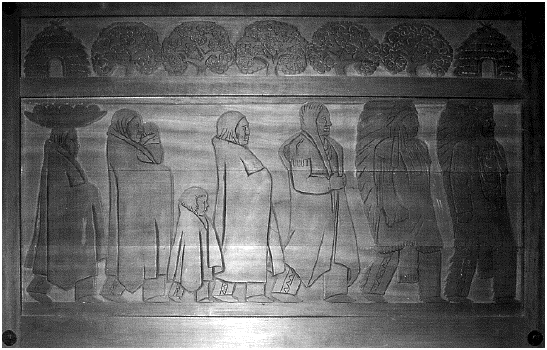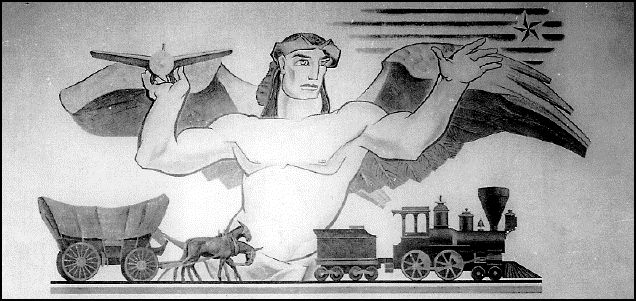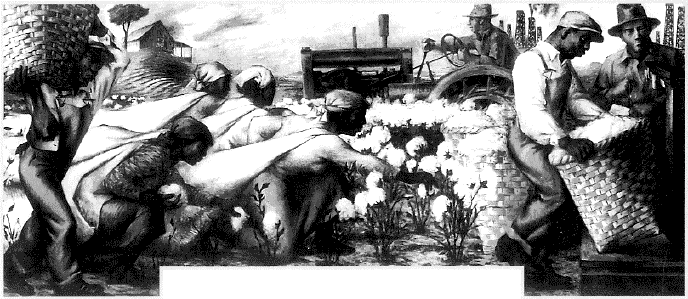
The Texas
Post Office
Murals:
Art for
The People
Philip Parisi
(Texas A&M University Press)

Francis Biddle, friend to Franklin D Roosevelt and collector of fine art, suggested that the New Deal works program --- Works Project Administration --- should include jobs for fine artists. "Hell, they've got to eat just like other people," he said.He explained that the muralists Rivera, Orozco, and Siqueiros had given "visual messages of hope" to Mexicans and that a similar experiment in America could "express in living monuments the social ideals that you are struggling to achieve."
So the Public Works of Art Project was established, and later, under the Treasury Department, increased vastly in scope as the Section of Fine Arts. One percent of the budget of all new post offices was set aside for murals. Competition was anonymous: color sketches would go to a local citizens committee for prescreening, and those deemed worthy would be forwarded to Washington for final judging.
As Parisi points out, the selection process "gave all competing artists, regardless of their ethnicity or gender, a fair opportunity... to land a contract."
As a result, the Section of Fine Arts stood out from other New Deal art programs, not only because of the competition for commissions that ensured work of the highest quality possible but also because of the democratic nature of the selection process.
§ § §
This volume consists of sixty-nine of the 106 artworks that appeared in Texas post offices. The reproductions in the book are mostly in color, and are of fine quality. Eight murals that have been destroyed or put into storage are represented by photographs drawn from the archives of the Section of Fine Arts.
Some of this government-sponsored art is genuinely powerful stuff. Tom Lea's "Stampede" in Odessa is a wonderful picture of confusion, a forest of horns, lightning, falling cowboys, and bovine madness: the lead bull is rising up red-eyed, looking as if he will be jumping out at us as we wait patiently in line for our stamps.
The post office in Baytown got "Texas" [Fig. 3] an allegorical picture of a hunky bare-chested god, complete with wings, about to cast an airplane out over the box-holders. The committee that awarded the contract to artist Barse Miller got the willies, found his heroic figure perhaps a bit too heroic. He was invited to show a little less crotch. He accomplished this by enlarging the 19th Century train at the bottom of the picture and by upping the loin-cloth to a more seemly navel level.
One of the best examples of the impact of community fears is the image [Fig. 2] by Frank Mechau. It appears in the Brownfield post office. It is supposed to be one of cowboys dousing a prairie fire by, yetch, dragging a recently butchered cow across the fire line.
The local postmaster was not impressed by the early sketches, even though the Cow Body Drag was the true-to-
life methodology of dealing with such blazes (dead cows were easier to come by than fire trucks). In addition, he opined that "the cowboys do not look like our kind. They look to [sic] much like Spaniards." Mechau responded by saying that
They might well look greasy after fighting fire and smoke for a few days. How ever, I shall see to it that they have a Nordic profile and a blue eye shining through the sweat.
That some of these murals created controversy is not so unusual. What is strange is that so many got mounted despite possible controversy. Along with the usual husky men in buckskins hewing wood and drawing water, there are a fair number of depictions of harsher, more grisly work --- murals probably inspired by the Mexicans that Biddle had referred to. There are depictions of workers welding heavy pipe, men sweating in the oilfields, wrestling with cattle, working the fields.
One by California artist Victor Arnautoff shows black men and women dragging huge cotton sacks behind them. The workers are stooped low to the ground, seemingly in the agony of their work. To underline the message for the proletariat, there is a mansion on the hill in the background, and, off to the right, a bare wooden hovel ... obviously the home of the workers.
§ § §

Despite being now inundated by Picasso, Dali, Cezanne and what one artist called "Jack the Dripper," I suspect there is a bit of New Realism in all of us. I think we all respond to Art with a Purpose, even if it is the merry Saturday Night Cowboy Dance, or the laborers in the sun: the hearty loggers, the stooped workers of the fields, cowboys herding and branding and surviving stampedes. It's the Muscle-and-Sweat School of Art. Good for the masses depositing their Postal Savings downtown, right? But there is no pure image in painting. It passes through the hands of artists, who necessarily shade the subject to match his or her own prejudices. Some of what appears here is as Biddle wanted it: "to give visual messages of hope." But artists are a noxiously independent lot, and we cannot help but feel their resentment in a government that many of them believed to be selfish, dangerous, and dying: the very government that, ironically, put them to work.
In our review of Wall to Wall America, an earlier book about WPA murals, we told of one in particular, Stefan Hirsch's Justice as Protector and Avenger. It was one that gave dyspepsia to the home folk in Aiken, South Carolina.
They went bananas over if because the figure of justice appeared to be a "mulatto" (not to be idolized in the deep South) and because there was a representation of "a burning house, a shyster lawyer freeing a prisoner from jail and a burglar pursuing his trade." A local judge questioned whether the mural was "a work of art or a monstrosity." An official of the PBA went to Aiken, took a gander, and subsequently authorized "the purchase of a tan velvet curtain on a drawstring...
to be placed over the mural --- so that it can be covered through court sessions and opened to the public on request." The author of Wall-to-Wall Art opined that the mural offended the people of Aiken because they much preferred Hollywood reality, or perhaps Mickey Mouse as that notorious roustabout, Steamboat Bill. It was "a phantom mural for a phantom people who didn't live in Aiken, South Carolina," the editor concluded.
The primary feeling left with readers of these books is one of awe. That a government agency could so generously support the arts without the fear that the artists would terrify the gentry, that the decorum of the state would be breached by a radical message plastered here or there in our post offices. Can you imagine the present administration giving carte blanche to a bunch of painters, offering them whole walls with which to decorate our daily world with not only the freedom but the wherewithal with which to do it?
Imagine that one coming out of present-day Washington. It boggles the mind.
As does the mot, mounted over the door of the El Paso post office, painted in capital letters by the artist Tom Lea:
O PASS OF THE NORTH
NOW THE OLD GIANTS ARE GONE
WE LITTLE MEN LIVE WHERE HEROES
ONCE WALKED THE INVIOLATE EARTH

--- Fredricka Massey, PhD